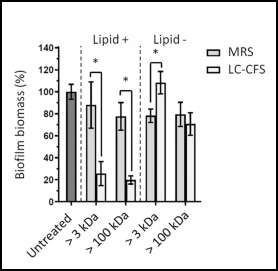|
Cleanascite™ Employed to Investigate Membrane Vesicle Influences on Bacterial Biofilms Biotech Support Group reports on an article, describing the simplicity and efficiency of their lipid binding technology to determine the influence of probiotic membrane vesicles on antimicrobial activity. News Release
Cleanascite™ Employed to Investigate Membrane Vesicle Influences on Bacterial Biofilms
MONMOUTH JUNCTION, NJ, January 27, 2023 -- Biotech Support Group reports on an article, describing the simplicity and efficiency of their lipid binding technology to determine the influence of probiotic membrane vesicles on antimicrobial activity.
The article states “To investigate the effect of L. casei BL23 on S. Enteritidis biofilm formation, we first quantified the biofilm biomass formed after treatment with several fractions of L. casei BL23 cell-free supernatant (LC-CFS). To this end, the LC-CFS and the growth medium of the bacteria (i.e. MRS) were fractionated by size-exclusion ultrafiltration to obtain several fractions ranging from 3 kDa to over 100 kDa”.
“Next, we decided to remove all lipids from LC-CFS > 100 and LC-CFS > 3 fractions and their corresponding controls (MRS > 100 and MRS > 3) using a lipid removal reagent…Cleanascite; following the manufacturer’s instructions.” “The antibiofilm activity of the delipidated fractions (Lipid −) was then compared to the initial fractions (Lipid +) by crystal violet staining (Fig.)…we saw a significant increase in biomass formation with the delipidated LC-CFS > 3 fraction compared to the control (MRS > 3) and the untreated fractions.” The report showed that the cell-free supernatant (LC-CFS) and the cell lysate of L. casei BL23 have a strong antibiofilm activity against S. Enteritidis, whereas live cells have no significant effect. Furthermore, it was demonstrated that membrane vesicles (LC-MVs) released by L. casei BL23 contribute to the antibiofilm activity of LC-CFS but have no impact on bacterial growth. In addition, it was showed that LC-MVs have a strong antibiofilm effect at the early stage of biofilm formation and no effect on established biofilms of S. Enteritidis. Finally, it was demonstrated that proteins associated with LC-MVs are responsible for the antibiofilm effects of the vesicles, and two peptidoglycan hydrolases (PGHs) were found to be involved in vesicle activities. “This
is now the second published report showing that Cleanascite™
efficiently removes membrane and extracellular vesicles, to determine
their influence on cellular activity.
Unlike alternative lipid removal methods that use solvents,
Cleanascite™ is an aqueous suspension product and so it is very
compatible with cellular response assays such as those used here.
This ultimately helps with investigations such as this, that need to
determine whether or not lipids, or factors associated with lipid
such as extracellular vesicles, impart phenotypic changes to cells.”
states Swapan Roy, Ph.D., President and Founder of Biotech Support
Group. Link to view our case study, Diverse technologies available for researchers to selectively bind or enrich exosomes and extracellular vesicles.
Link to view application report entitled “LIPID REMOVAL & CELL RESPONSE APPLICATIONS”
For
more information visit: Cleanascite™ Lipid Removal Reagent and
Clarification,
at |

- About
- Products
- Hemoglobin Removal Kits
- Lipid Removal & Clarification
- Urine Protein & Low Abundance Enrichment
- Class Specific Enrichment
- Sample Prep Mass Spectrometry
- Functional & Chemical Proteomics
- Genomic Sample Prep
- Accessories
- Technical Resources
- References
- Publications & Reports
- FAQs
- Case Studies
- Cleanascite™ Unlocks Insights into Lipid-Driven Tumor Immunosuppression
- NRicher™ Bead Platform Provides Unique Sub-Proteome Biases And Fit For Purpose Opportunities for Targeted LC-MS Quantification
- BSG Products To Assist in Analyzing Macrophage Polarization
- Ectodomain Shedding and Enrichment of the Soluble Membrane Proteome
- Investigate out of the Venn Diagram box
- Methods to selectively deplete or purify Hemoglobin from Dried Blood Spots (DBS)
- The Utility of HemoVoid™ is Demonstrated in 3 Proteomic Investigations Identifying Potential Disease Specific Biomarkers
- The 4 common features of our sample prep products, known as the BSG Advantage, are highlighted in a selection of journal references.
- AlbuVoid™ Workflows Advance Cell Secretome Proteomics
- Lipid Removal for Phenotypic Cell Response in Cancer Research
- The Influence of Sample Prep Bias on LC-MS Targeted Peptide Quantification in Serum Proteomics
- Re-imagining proteomics for developing precision medicine biomarkers of the innate immune response in SARS-CoV-2
- Patent Application Describes New Proteomic Methods to Monitor Protease Inhibitor Function During Covid-19 Infections
- Efficient Hemoglobin Removal Advances Red Cell Proteomics Offering Many New Insights Into Inflammation and Infectious Disease
- The Potential for New Blood Biomarkers in the Management of COVID-19 Disease
- Establishing the Utility of HemoVoid™ and HemogloBind™ as Enrichment Tools for Proteomic Analysis of Red Cells and Whole Blood in Parkinson’s Disease
- Species Diversity Supported By BSG Products
- Poster Report Describes Loss of Functional Serpin Activity In Cancer Patient Blood
- AlbuVoid™️ PLUS & AlbuSorb™️ PLUS Evaluating Different Windows of Observation Solves The Many Challenges of Serum Proteomics
- Tackling the Challenges of Serum Proteomics
- Lipid Removal Sample Prep for Cell Response Applications
- Sample Prep for Proteomic Analysis of Saliva
- Biotech Support Group Featured in Book, "Functional Proteomics – Methods and Protocols"
- Sample Prep Liquid Biopsy Products Suitable for Proteomic Profiling of a Variety of Body Fluid Sample Types
- Albumin and High Abundance Depletion
- Using HemogloBind™ as a Hemoglobin Binding Reagent
- Diverse technologies available for researchers to selectively bind or enrich exosomes and extracellular vesicles.
- Stroma Liquid Biopsy™ Biomarkers Profile Pan-Cancer Dysregulation of the Serum Proteome
- Diverse Depletion and Enrichment Technologies Enhance Simplicity and Efficiency of Obtaining Quality Proteomic Information
- Use On-Bead Digestion to Improve Time Required for Serum Digestion
- Using AlbuVoid™ as a Serum Protein Enrichment Kit in Functional Proteomics
- Using Cleanascite™ as a Lipid Absorption and Clarification Reagent
- Using HemoVoid to Remove Hemoglobin Before Analysis
- Blog
- Contact
- Liquid Biopsy

